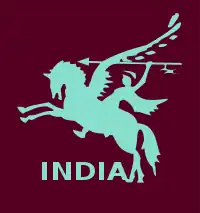| 44th Indian Airborne Division | |
|---|---|
 Unit Insgina | |
| Active | 1944–1947 |
| Country | |
| Allegiance | |
| Branch | |
| Type | Airborne forces |
| Size | Division |
| Engagements | World War II |
| Commanders | |
| Notable commanders | Ernest Edward Down |
| Insignia | |
| Identification symbol | Winged Pegasus on a Scarlet background with India underneath |
The 44th Indian Airborne Division was an airborne forces division of the Indian Army during World War II, created in 1944. It provided a parachute battalion for one minor airborne operation, but the war ended before the complete formation could take part. (However, most of its subordinate formations and units had already seen action before the division had been formed).
History
Creation
The division's creation was a protracted affair. The division was first converted from the 9th Airborne Division (itself built around the core of the disbanded 44th Indian Armoured Division), at Secunderabad in India, on 15 April 1944.
Within a fortnight, the division HQ and such supporting units as had been allocated were used to form the 21st Indian Infantry Division, as an emergency measure during the Japanese invasion of India (which was codenamed Operation U-Go, and which resulted in the battles of Imphal and Kohima). By 15 July, the crisis was clearly over, and the airborne division's formation was resumed.
Formation
On 15 September 1944, the existing 50th Indian Parachute Brigade was allocated to the division. Later in the year, it was decreed that the Chindit formations were to be broken up and some of them were to be converted to airborne formations. The 14th British Airlanding Brigade became part of the division on 1 November 1944, and the Indian 77th Indian Parachute Brigade on 1 March 1945.
The conversion of 77th Brigade to a parachute formation was accompanied by the creation of the Indian Parachute Regiment, which absorbed the existing Indian and Gurkha parachute battalions, and the formation of two British battalions of the Parachute Regiment around the cadre of troops that had already fought as Glider infantry during the Chindit campaign; 15th (King's) Battalion, Parachute Regiment from 1st Battalion King's Regiment (Liverpool), and 16th (Staffords) Battalion, Parachute Regiment from 1st Battalion South Staffordshire Regiment.
Operation Dracula
The division was still in the midst of formation, reorganisation and training when it was called upon to provide a parachute force to take part in Operation Dracula. This was an amphibious operation intended to capture Rangoon, the capital and principal port of Burma, which was reinstated at short notice after being earlier cancelled.
A composite Gurkha parachute battalion was formed from the two Gurkha battalions of the Indian Parachute Regiment, and landed behind Japanese coastal defences at the mouth of the Rangoon river on 1 May 1945. During the Battle of Elephant Point, they cleared Japanese rearguards from the defences, but the main Japanese garrison had evacuated Rangoon several days previously. The subsequent landings from the sea were unopposed.
Later Operations

The division was preparing to take part in the projected invasions of Malaya and Singapore when the war ended unexpectedly. The division provided small airborne parties that landed in Japanese-occupied territories ahead of the main Allied forces, locating camps containing Allied prisoners of war and interned civilians, and delivering emergency relief supplies. The 44 Indian Airborne Division moved to Bilaspur in June 1945.[1] The division was then re-named the 2nd Indian Airborne Division and was retained until the Partition of India, when it was disbanded on 14/15 August 1947.[2] One parachute brigade and some divisional units went to Pakistan, the other two brigades and the remaining units went to India.
Order of Battle, as of 1 May 1945
- General Officer Commanding - Major General Earnest Edward Down
- Commander, Royal Artillery - Brigadier Reginald John Kirton
- 14th British Airlanding Brigade - Brigadier Francis William Gibb
- 2nd Battalion, Black Watch (Royal Highland Regiment)
- 4th Battalion, 6th Rajputana Rifles
- 6th Battalion, 16th Punjab Regiment
- 50th Indian Parachute Brigade - Brigadier Edward Galbraith Woods
- 16th (Staffords) Battalion, Parachute Regiment
- 1st Battalion, Indian Parachute Regiment
- 3rd Battalion, Indian Parachute Regiment
- 77th Indian Parachute Brigade - Brigadier Claude John Wilkinson
- 15th (King's) Battalion, Parachute Regiment
- 2nd Battalion, Indian Parachute Regiment
- 4th Battalion, Indian Parachute Regiment
- Divisional Units
- 123rd (West Riding) Field Regiment, Royal Artillery[3]
- 159th Field Regiment, Royal Artillery[4]
- 23rd Light Anti-Aircraft / Anti-Tank Regiment, Royal Artillery
External links
- "44 Airborne Division". Orders of Battle.com.
References
- ↑ "Indian Airborne Divisional Artillery | ParaData".
- ↑ Renaldi and Rikhye 2011, p.35
- ↑ "Orders of Battle.com". Archived from the original on 23 March 2017. Retrieved 22 March 2017.
- ↑ "Orders of Battle.com". Archived from the original on 23 March 2017. Retrieved 22 March 2017.